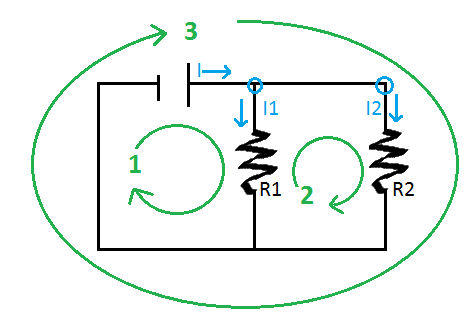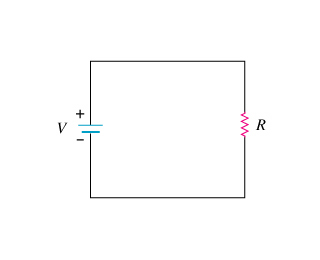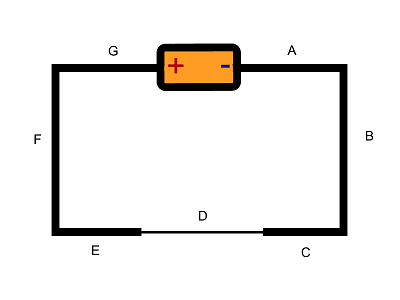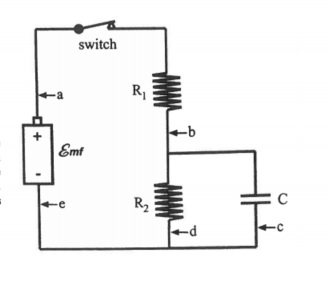Kirchoff's Laws
Created by Aditya Kuntamukkula - Spring 2018
Kirchoff's Laws are are two fundamental principles of electric circuits and are used to determine the behaviors of electric circuits and their components.
Kirchoff's Node Rule, also known as Kirchoff's First Law or Kirchoff's Junction Rule, further exercises the law of Conservation of Charge and states that if current is constant, all the current that flows through one junction must be equal to all the current that flows out of the junction. This rule can be applied both to conventional and electron currents. This rule is not a fundamental principle, but rather a consequence of the fundamental principle of conservation of charge and the definition of steady state.
Kirchoff's Second Law, also known as Kirchhoff's Loop Rule or Kirchhoff's Voltage Law states that the sum of potential differences around a closed circuit is equal to zero. More simply, in a completed circuit, the voltages around a loop will sum to 0. This is because voltage is just energy per unit charge, and both energy and charge are conserved by fundamental laws.
Note that is only true when the magnetic field is neither fluctuating nor time varying. If a changing magnetic field links the closed loop, then the principle of energy conservation does not apply to the electric field, causing the Loop Rule to be inaccurate in this scenario.
Kirchoff's Node Rule
The node rule states that at any junction in an electrical circuit, the amount of current flowing into the junction is equal to the amount of current flowing out of the junction in steady state.
In the steady state, for many electrons flowing into and out of a node,
- electron current: [math]\displaystyle{ net\ i_{in} = net\ i_{out}, }[/math] where [math]\displaystyle{ i = nA\mu }[/math][math]\displaystyle{ E }[/math]
- conventional current: [math]\displaystyle{ net\ I_{in} = net\ I_{out}, }[/math] where [math]\displaystyle{ I = |q|nA\mu }[/math][math]\displaystyle{ E }[/math]
Conservation of Charge
This rule is an application of the conservation of electric charge, basically that charge within a circuit cannot be created or lost. During the flow process around the circuit, there is no loss of any charge, thus the total current in any cross-section of the circuit is the same. If there are no nodes in the loop, the conventional current is the same throughout the loop.
A Mathematical Model
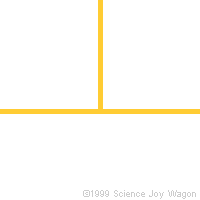
The node rule can be stated as:
- [math]\displaystyle{ \sum \Delta{I} = 0 }[/math]
where [math]\displaystyle{ I }[/math] stands for the current of the individual parts or wires in a circuit and the sign of the current that flows into the junction is opposite of the current that flows out of the junction. This simply supports the idea that energy cannot be created or destroyed because the total current must remain equal regardless of the path it takes.
- [math]\displaystyle{ \sum_{k=1}^n I_k = 0 }[/math]
where [math]\displaystyle{ n }[/math] is the total number of branches with current flowing through the node, as well as
- [math]\displaystyle{ \Delta {I}_{1} + \Delta {I}_{2} + \space.... = 0 }[/math]
along any node in a circuit.
- [math]\displaystyle{ \sum_{k=1}^n \tilde{I_k} }[/math] = 0
for complex currents.
A Computational Model
- In an electric circuit in series, electrons flow from the negative end of a power source, creating a constant current. This current remains consistent at each point in the circuit in series. Sometimes, a circuit is not simply one constant path and may include parts that are in parallel, where the current must travel down two paths such as this:
- File:Noderule.jpg
- In this case, when the current enters a portion of the circuit where the items are in parallel, the total amount of current in must equal the total amount of current out. Therefore, the currents in each branch of the parallel portion must sum up to the amount of current at any other point in series in the circuit.
- People also call this the "Junction Rule"
- Another important point is that this comes from the Kirchoff's Circuit Laws
Examples
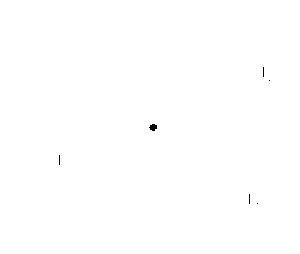
Ex. 1
Figure 1 displays a node in a circuit. I1 is equal to 10 amps. I2 is equal to 4 amps. What is I3?
- The current flowing into the node: [math]\displaystyle{ I_1 = 10A }[/math]
The current flowing out of the node: [math]\displaystyle{ I_2 + I_3 }[/math]
We know that the current flowing in must equal the current flowing out, so [math]\displaystyle{ 10A = 4A + I_3 }[/math]
Therefore [math]\displaystyle{ I_3 }[/math] must equal 6A.
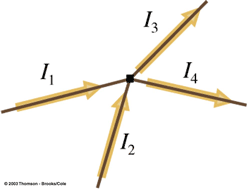
Ex. 2
In Figure 2, I1 equal 23 amps, I2 equals 5 amps and I3 equals 42 amps. What is I4?
- The current flowing into the node: [math]\displaystyle{ I_1 + I_2 = 23A + 5A = 28A }[/math]
The current flowing out of the node: [math]\displaystyle{ I_3 + I_4 = 42A + I_4 }[/math]
Applying the node rule by using substitution, [math]\displaystyle{ I_4 = -14A }[/math]
But how could we get a negative current? Getting a negative current is physically (no pun intended) impossible, but when our current comes out negative, it simply lets us know that we guessed the direction of I4 incorrectly. We assumed that the unknown current flows out instead of into the node when, in fact, the current flows into the node.
Kirchoff's Loop Rule
The loop rule simply states that in any round trip path in a circuit, Electric Potential equals zero. This applies through any round trip path; In more complex circuits, there can be multiple round trip paths. This principle is an application of the conservation of energy, specifically within a circuit. This principle is often used to solve for resistance or current passing through of light bulbs and other resistors, as well as the capacitance or charge of capacitors in a circuit.
A Mathematical Model
A mathematical representation is:
- [math]\displaystyle{ \sum_{i=1}^n {V}_{i} = 0 }[/math]
where [math]\displaystyle{ n }[/math] is the number of voltages being measured in the loop, as well as
- [math]\displaystyle{ \Delta {V}_{1} + \Delta {V}_{2} + \space.... = 0 }[/math]
along any closed path in a circuit.
A Visual Model
LOOP 1: [math]\displaystyle{ \Delta {V}_1 = emf - I_1R_1 = 0 }[/math]
LOOP 2: [math]\displaystyle{ \Delta {V}_2 = -I_1R_1 + I_2R_2 = 0 }[/math]
LOOP 3: [math]\displaystyle{ \Delta {V}_3 = emf - I_2R_2 = 0 }[/math]
To figure out the sign of the voltages, act as an observer walking along the path. Start at the negative end of the emf and continue walking along the path. The emf will be positive in the loop rule because you are moving from low to high voltage. Once you reach a resistor or capacitor, this will be negative in the loop rule equation because it is high to low voltage. Continue along the path until you return to the starting position.
Examples
Simple
The circuit shown above consists of a single battery and a single resistor. The resistance of the wires is negligible for this problem.
Problem:
If the [math]\displaystyle{ emf }[/math] is 5 V and the resistance of the resistor is 10 ohms, what is the current passing through the resistor?
Solution:
Although we can solve this using the [math]\displaystyle{ V = IR }[/math] equation for the whole loop, let's examine this problem using the loop rule equation.
The loop rule equation would be [math]\displaystyle{ {V}_{battery} - {V}_{resistor} = 0 }[/math]
Since we know the [math]\displaystyle{ emf }[/math] of the battery we just need to find the potential difference through the resistor. For this we can use the equation of [math]\displaystyle{ V = IR }[/math].
Thus we now have an loop rule equation of [math]\displaystyle{ emf - IR = 0 }[/math] From here it is a relatively simple process to find the current. We can rewrite the loop rule equation as [math]\displaystyle{ emf = IR }[/math] and then plug in 5 for the emf and 10 for the resistance, leaving us with I = .5 amperes.
Middling
Problem:
The circuit shown above consists of a single battery, whose [math]\displaystyle{ emf }[/math] is 1.3 V, and three wires made of the same material, but having different cross-sectional areas. Let the length of the thin wires be [math]\displaystyle{ {L}_{thick} }[/math] and the length of the thin wire be [math]\displaystyle{ {L}_{thin} }[/math] Find a loop rule equation that starts at the negative end of the battery and goes counterclockwise through the circuit.
Solution:
When beginning this problem, you must notice that the difference in cross-sectional areas affects the electric field in each wire. Because of this we will denote the electric field at D. as [math]\displaystyle{ {E}_{D} }[/math] and the electric field everywhere else as [math]\displaystyle{ {E}_{A} }[/math]. To begin we will go around the circuit clockwise and add up each component. First, we know that the [math]\displaystyle{ emf }[/math] of the battery is 1.3 V. Then, we will add up the potential voltage of each of the wires.
Remember that the electric potential of a wire is equal to the product of the electric field and the length of the wire. From this we can now find the potential difference of each section of the wires. The electric potential of location A - C is [math]\displaystyle{ {E}_{A} * {L}_{thick} }[/math]. This is the same for the electric potential of locations E - G of the wire. For the thin section of the wire, the electric potential is [math]\displaystyle{ {E}_{D} * {L}_{thin} }[/math]. From here we just go around the circuit counterclockwise and add each potential difference to the loop rule equation.
Thus we can find that a loop rule equation is: [math]\displaystyle{ emf - 2 ({E}_{A} * {L}_{thick}) - {E}_{D} * {L}_{thin} = 0 }[/math]
This can also be rewritten as: [math]\displaystyle{ emf = 2 ({E}_{A} * {L}_{thick}) + {E}_{D} * {L}_{thin} = 0 }[/math]
Difficult
Problem:
For the circuit above, imagine a situation where the switch has been closed for a long time. Calculate the current at a,b,c,d,e and charge Q of the capacitor. Answer these using [math]\displaystyle{ emf, {R}_{1}, {R}_{2}, and \space C }[/math]
Solution:
First, write loop rule equations for each of the possible loops in the circuit. There are 3 loop equations that are possible.
[math]\displaystyle{ emf - {I}_{1}{R}_{1} - {I}_{2}{R}_{2} = 0 }[/math]
[math]\displaystyle{ emf - {I}_{1}{R}_{1} - Q/C = 0 }[/math]
[math]\displaystyle{ {I}_{2}{R}_{2} - Q/C = 0 }[/math]
From here, we can then solve for the current passing through a,b,d and e. We also know that the current passing through these points must be the same so [math]\displaystyle{ {I}_{1} = {I}_{2} }[/math]
[math]\displaystyle{ emf - {I}_{1}{R}_{1} - {I}_{1}{R}_{2} = 0 }[/math]
[math]\displaystyle{ emf = {I}_{1}({R}_{1} + {R}_{2}) = 0 }[/math]
[math]\displaystyle{ emf/({R}_{1} + {R}_{2}) = {I}_{1} }[/math]
So the current at [math]\displaystyle{ a,b,d,e = emf/({R}_{1} + {R}_{2}) }[/math]
You must also know that once a capacitor is charging for a long time, current no longer flows through the capacitor. We can then easily solve for c because since current is no longer flowing through the capacitor, the current at c = 0.
Lastly, we will use the loop rule equation of [math]\displaystyle{ {I}_{2}{R}_{2} - Q/C = 0 }[/math] to solve for Q.
[math]\displaystyle{ {I}_{2}{R}_{2} = Q/C }[/math]
[math]\displaystyle{ C*({I}_{2}{R}_{2}) = Q }[/math] Since [math]\displaystyle{ {I}_{1} = {I}_{2} }[/math]
[math]\displaystyle{ C*({I}_{1}{R}_{2}) = Q }[/math] Lastly, we will plug in what we found {I}_{1} equals from before.
[math]\displaystyle{ C* (emf/({R}_{1} + {R}_{2})){R}_{2}) = Q }[/math]
Lastly, [math]\displaystyle{ Q = C* (emf/({R}_{1} + {R}_{2})){R}_{2} }[/math] and we have now solved the problem.
Answers:
Current at [math]\displaystyle{ a,b,d,e = emf/({R}_{1} + {R}_{2}) }[/math]
Current at [math]\displaystyle{ c = 0 }[/math]
[math]\displaystyle{ Q = C* (emf/({R}_{1} + {R}_{2})){R}_{2} }[/math]
Limitations
Time-Varying Currents
Kirchhoff's law is based off the conservation of charge along with the nature of conductors. This law assumes that current will immediately flow from one end of the conductor to the other, which may not be true for time-varying currents, especially with higher frequencies.
Regions vs Circuits
Throughout a region, the charge can vary and be non-uniform, unlike in a wire. According to the law of conservation of charge, the only way to have a non-uniform charge density is if there is a net flow of current in or out of the region, which clearly violates the Node Rule. Therefore the node rule cannot be applied to regions with non-uniform charge densities. When looking at a junction in an electric circuit, we are looking at a point and therefore the point (which is infinitesimally small) must have a uniform charge distribution. In general, wires should have a uniform charge distribution across their length, because they are conductors and allow for the movement of charge.
Non-Steady State
The node rule can only be applied to the steady state. Thus, when considering the capacitor, the node rule is applied to the capacitor as a whole not just one plate of the capacitor.
Other Topics
Solving Circuits
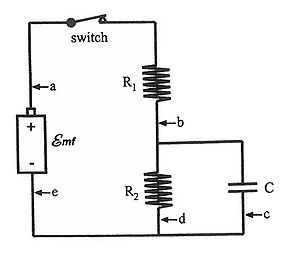
In order to solve circuits, we must first define a couple characteristics of circuits.
- The voltage of a (perfect, or non-resistive) wire is equal to its length (in meters) times its electric field.
- The voltage of an ohmic resistor (including a resistive wire) is equal to current times resistance.
- The voltage of a capacitor is equal to the charge on the capacitor divided by its capacitance.
There are other characteristics and equations that may be useful, but these two are the most important and used. If you are confused by any of the components of circuits mentioned above, visit the "Components" page. Below is a circuit. Using the node and loop rules we will find the current at points a, b, c, d, and e, and the charge on the capacitor after the switch has been closed for a very long time.
First you must realize that when the capacitor is fully charged, no current will flow through the capacitor, which is an important characteristic of a capacitor. From this we can say that the current through point c is 0.
Using the node rule, we can see that the current through resistor 1 and resistor 2 must be the same because, since no current flows through the wire connected the capacitor, all of the current must flow through one loop containing both resistors. So the current at a, b, d and e must all be the same. Due to the loop rule, the emf of the battery must be equal to I*R1 + I*R2. Therefore, I = emf/(R1 + R2); this is the current through points a, b, d and e. Using the loop rule, we can look at the loop containing the capacitor and resistor 2. We know the voltage in resistor 2 is equal to I*R2. We know the voltage of the capacitor is equal to its charge divided by C (its capacitance). Because of the loop rule, we know that these two voltages must be equal, so I*R2 = Q/C. Therefore, Q = I*R2*C. Replacing I with the current we found above, Q = (emf/(R1 + R2))*R2*C. As you can see, in order to solve this circuit, we had to use the node rule. In fact, we used the node rule at the very beginning of solving this circuit and there was no way possible we could have solved this problem without the node rule.
Here is a link to a helpful video explaining the node rule with the following circuit and the case where the switch has just been closed so the capacitor is not fully charged: https://youtu.be/nyYA0d7rQzE
History
Gustav Kirchhoff was a German physicist who lived during the 19th century. There are many equations and laws named after him that he helped to discover. His circuit laws (the node rule and loop rule) were the first laws that he conceived, and discovered this during his time as a student at Albertus University of Königsberg in 1845; he later wrote his doctoral dissertation on these laws. Kirchoff went on to explore the topics of spectroscopy and black body radiation after his graduation from Albertus. In addition to his circuit laws, he is also known for his law of thermochemistry and three laws of spectroscopy, the latter of which helped lead to quantum mechanics.
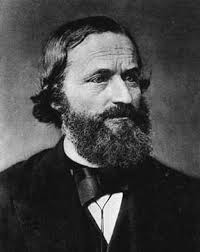
Connectedness
The Node Rule is connected to a lot of other topics in physics. The loop rule is the most important one, as the node rule and loop rule in conjunction allow us to solve circuits. The node rule is also connected to other concepts such as voltage, current and electricity. The Node Rule is also supports the law of conservation of energy because in essence, current is simply the flow of electric charge, and since you cannot (at least as of now) create energy or electrons out of nothing, everything that is put into the system must come out somehow. Therefore, all the current that is applied, must come out the other end.
See Also
Further Reading
External Links
https://en.wikipedia.org/wiki/Kirchhoff%27s_circuit_laws#Kirchhoff.27s
http://www.tutorvista.com/content/physics/physics-iv/current-electricity/kirchhoffs-rules.php
References
- Matter & Interactions 4th Edition by Ruth W. Chabay & Bruce A. Sherwood
- http://www.regentsprep.org/Regents/physics/phys03/bkirchof1/
- https://en.wikipedia.org/wiki/Kirchhoff%27s_circuit_laws#Kirchhoff.27s
